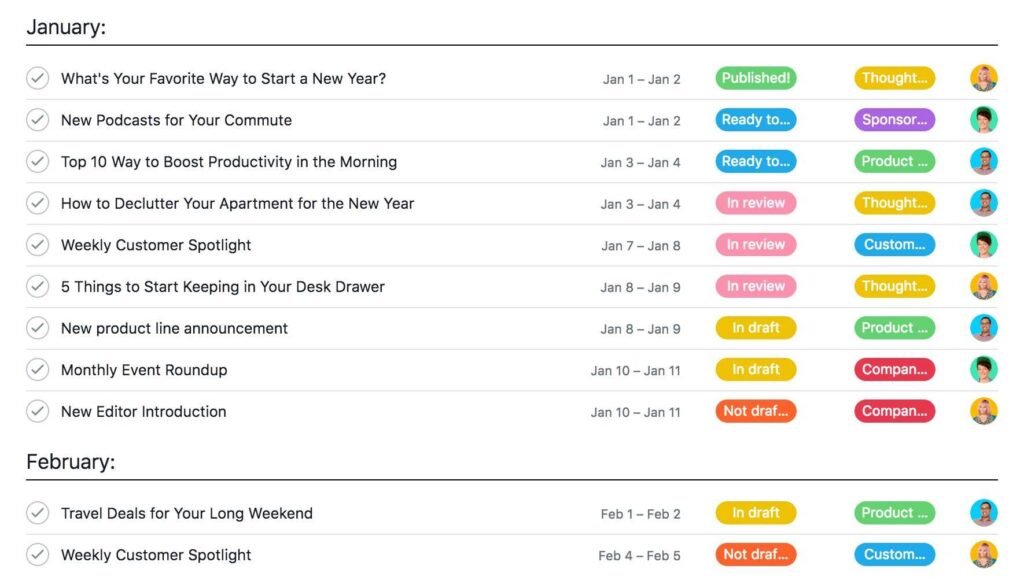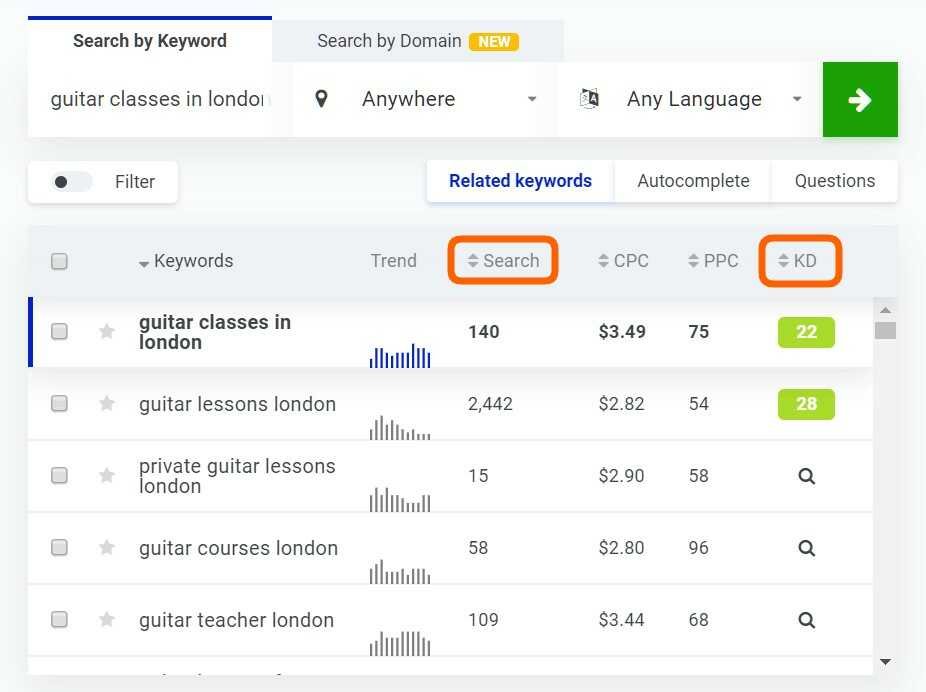Fifty-one percent (51%) of the businesses that invest in content marketing publish content daily.
But regardless of how frequently you post on your blog or social media, your content creation process can have a lot of moving parts.
A number of people and tools are involved in the ideation, writing, and publishing of content. And it can get complicated fast.
That means sooner or later, you’ll find it hard to keep track of assigned topics, timelines, and resources.
The solution: an editorial calendar, aka content calendar.
In this guide, we’ll define what an editorial calendar is, review its benefits, and explain how to create your own quickly and easily.
Disclaimer: If you buy any products through links on this site, I may earn a commission. But it doesn't make any difference to your cost, and it helps me keep this blog running. So you could always read my articles for free.
What is a content calendar?
A content calendar (also known as an “editorial calendar”) is a documented plan of what, when, and where you will publish in the upcoming months.
It is a system to keep track of the topics you plan to write, who will write them, when to publish, and other essential details to help streamline the content creation process.
The editorial calendar also monitors the status of development for each piece of content, along with sharing strategic data for content writers and editors, such as keyword focus, notes, takeaways, research, etc.
It is most commonly created and managed as a spreadsheet. But it can also take on other formats like a calendar, document, and kanban board.

Whatever format you use, it should be something that’s easy to view and manage for everyone in your team. That way, you can ensure that everything is organized and moving.
Why is a content calendar important?
A content calendar enables you to organize content creation, collaborate with ease, and plan your upcoming content on a high level.
If you’re using content to promote your company, you can’t afford to be disorganized. An editorial calendar provides planning and organization to make sure everyone in your content team is on the same page. It helps you in the following ways:
Organized content creation
A 2022 report by CoSchedule says that organized marketers are 674% more likely to report success than their peers.
An editorial calendar ensures the execution of all your content-related tasks because it puts them out there for everyone to see.
Without it, for example, you or someone in your team may forget to do certain tasks, write less often, or ignore the old pieces.
But when using a content calendar, you increase the odds that nothing slips through the cracks.
Easy collaboration
In a survey by Content Marketing Institute (CMI), 58% of respondents said their top challenge is communication among teams.

Image Source: Content Marketing Institute
An editorial calendar goes a long way to help with this problem. It makes it easier to collaborate as a team and get things done.
High-level planning
With a content calendar, you get a birds-eye view of all your upcoming content. For example, when you notice all your material from a high level, you may spot mistakes such as:
- Sharing a bunch of promotional posts at once, instead of spacing them out.
- Creating two pieces of content on very similar topics.
An editorial calendar helps prevent such mishaps and lets you see ideas to improve your content plan.
Building an editorial calendar
To build an editorial calendar, you need to generate content ideas, prioritize your content topics, fill up your editorial calendar, and update it regularly. Include details such as content type, keyword, writer, completion, and publication date for each piece of content.
Without an editorial calendar in place, you or your team will soon reach a point where they are just throwing together content for the sake of it. As they say, failing to plan is planning to fail.
So let’s take a look at the steps you need to develop and start using an editorial calendar for your brand.
Generate content ideas
Find out the kind of questions new prospects or customers often ask you or your sales team and use them to generate content ideas.
Depending on how much content you plan to produce in the next 6 to 12 months, you’ll need new topics to write about.
If you already have some published content, then your first step should be to conduct an audit. Analyze whether you have appropriate content for all the stages of your marketing and sales funnel.
This will help you identify areas where the content is lacking, and find opportunities to write new content related to something you have already written before.
If you are just starting or need new ideas from scratch, one way is to find out the kind of questions new prospects or customers often ask you or your sales team. These will lead to ideas that you should pursue first.
Not only will this help you build trust, but it will also empower the sales team and shorten the sales cycle.
Second, there are certain types of content proven to perform well in a number of industries. You can use them in the brainstorming process as broad categories to help generate ideas. These are:
Pricing/cost questions – For example, “How much does a smart home cost?”
Problems – For example, “4 signs there’s a leak on in your cloud security”
Tutorial/guides – For example, “How to lose 10 pounds in 3 weeks”
Comparisons – For example, “Ikea vs Walmart when buying new furniture”
Reviews – For example, “Is HP Spectre the best 15-inch laptop? A review”
Tips/hacks – For example, “10 ways to make money in real estate”
Top/best resource lists – For example, “Top 10 dandruff treatment shampoos in 2022”
Another way to get content inspiration is good old keyword research. In fact, a Databox survey shows that it’s the most popular technique to find content ideas.

Image Source: Databox
Answer the Public, for instance, is a free tool in which you can enter a word or phrase to generate content ideas.
If you have the budget, premium tools like KWFinder can also help you uncover fresh content topics to engage your audience.

The results will not just give you hundreds of keywords, but also show you how many times they are searched every month and how easy or difficult it may be to rank for them in search engines.
Prioritize your topics
Determine which content topics to address first. To do this, consider where in the buyer journey you are targeting your audience, and what action you want them to take.
By the end of content idea generation, you’ll probably have at least 50 topics to begin. But how do you know what to write about first?
As I have mentioned before, it’s always wise to take a look at where in the buyer journey you are targeting your audience, and what action you want them to take.
Do this for each topic you came up with. You want to start creating bottom-funnel content first, and then move up to middle and top-of-the-funnel content.
If you already have some published content, follow the same approach. Start by filling the gaps in your bottom-funnel content, and so on.
You also want to maintain the right proportion of entertainment, inspiration, and education in your monthly content.
For example, if you’re into a kid’s toys business, perhaps 50% of your topics should correspond to entertaining content, 25% educational, and 25% inspirational.
Similarly, a B2B consulting company may decide that 50% of its content topics will be educational, 25% inspirational, and 25% entertaining.
In addition, you’ll take these factors into account:
- Which products/services would you like to prioritize in the coming months?
- What are your short-term and long-term content goals?
- Which of your current content has gaps or no related content?
By prioritizing the topics related to the customer journey in reverse, you will be more likely to acquire customers sooner because you are starting with prospects who are already interested.
Fire up your content calendar
Fill up your content calendar with details such as content type, content freshness, focus keyword, desired URL and CTA, and assigned writer. Also include the completion and publication date for every piece of content.
Once you have brainstormed ideas and prioritized your content topics, it is time to start filling up your editorial calendar. You can use a ready-made template, or create a spreadsheet from scratch.
Here are the elements that are supposed to be in your editorial calendar, along with their explanations. You can also create additional data points for aspects that are unique to your brand and process.
- Content type – The type of content (blog article, podcast, video, infographic)
- Focus keyword – The keywords to be targeted for on-page SEO
- Desired URL – The permalink of the content when it’s published
- Desired call-to-action – CTA if you have something planned
- Assigned writer – Name of the team member to work on this content
- Completion date – When is the final draft expected to be ready by?
- Publication date – When do you expect to get this content published?
In the beginning, this may look overwhelming. You may feel like that is too much information to fill in for each piece of content.
But eventually, you’ll see that you and your team communicate better, wasting less time in back-and-forth emails and producing content better and faster.
Content creation is a breeze when everyone understands the scope of the piece, how it fits the content strategy, and what they need to fulfill their part. They don’t have to think over every little detail because much of it is already laid out.
By taking the time to make your blog calendar the right way from the beginning, you’re laying the foundation of a tight process that just works. There will be fewer mishaps, misunderstandings, and delays.
Keep it up to date
Ensure that you and your team are filling, referring to, and updating the content calendar often.
Last but not least, you or someone in your team will have to own the content calendar and push for its adoption, at least in the beginning.
When used for a few months, we’re sure the ease of keeping everything in sync will justify the little effort in maintaining the content calendar.
Being able to track all your content as it is being developed will give you a better sense of whether you are meeting your deadlines and if you need to modify anything in your content creation process.
A practical content planner allows you to easily view what stage each article is currently in. So make sure that you and everyone on your team are filling, referring to, and updating it often.
Frequently asked questions about a content calendar
Let’s see answers to some common questions about an editorial calendar.
How to create a content calendar?
It is most commonly created and managed as a spreadsheet, but can also be in other formats like a calendar, document, kanban board, or other software.
How to generate topics for a content calendar?
While prioritizing content topics, consider the products and services you would like to focus on in the coming months. Plus, take into account your short-term and long-term goals. And check which of your current content has gaps or no related content.
What should be included in a content calendar?
In an editorial calendar, include columns for content type, content freshness, focus keyword, desired URL, and desired CTA. Also, add details like the assigned writer, publication date, and completion date.
Final thoughts on content calendar
Building and using a content planner does take some work and patience, but it’s worth it. The ability to keep track of and scale your content creation can make a big difference in the success of your sales and marketing efforts.
So get started with an editorial calendar today! And once you modify it based on your unique process, make sure to maintain the same for accuracy.
Did we miss anything? Did you try these tips? Do you have any questions or comments? Share your thoughts below in the comments section.





